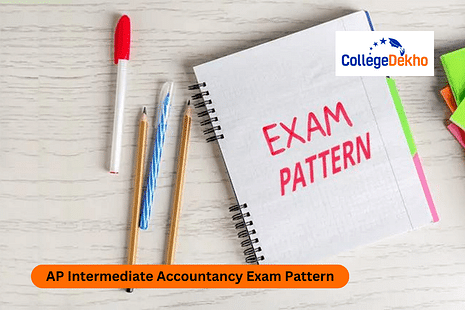

Never Miss an Exam Update
AP Intermediate Accountancy Exam Pattern 2024-25 will be released soon at bieap.apcfss.in. As per the previous year's exam pattern, the theory paper will be of 100 marks. The question paper will be divided into 2 parts, Part I - Commerce, and Part II - Accountancy with equal weightage of marks, i.e., 50 each. The AP Intermediate Accountancy question paper 2025 will have a total of 32 questions including MCQs, Very short, Short, and Long answer questions.
AP Intermediate Accountancy Syllabus 2024-25
covers 5 units and a total of 10 chapters, which are again divided into topics and sub-topics. Unit 2, Consignment Accounts and Accounting Not-for-Profit Organisation will carry the highest weightage of marks, i.e., 24 in the BIEAP intermediate exam. This is followed by Unit 3, Partnership Accounts, which will carry 22 marks in the exam.
The
AP Intermediate Time Table 2025
will be out by December 2024 and the exams will be conducted in March 2025. Read the complete article to know more about AP Intermediate Accountancy Exam Pattern 2024-25.
AP Intermediate Accountancy Exam Pattern 2024-25
In order to pass the BIEAP intermediate exam 2025, students must get a minimum of 35% in each subject. The unit wise marking scheme along with the exam pattern has been provided below.AP Intermediate Commerce Blueprint 2024-25 (Part-1)
| S.No. | Units | Essay - 10 Marks | S.A - 5 Marks | V.S.A - 2 Marks | Total Marks |
|---|---|---|---|---|---|
| 1 | Unit-1 Entrepreneurship Development | 5+5 | 2+2 | 14 | |
| 2 | Unit-2 Domestic and International Trade | 5+5 | 2 | 12 | |
| 3 | Unit-3 Business Services | 10 | 5 | 2+2 | 19 |
| 4 | Unit-4 Financial Markets | 10 | 5 | 2+2 | 19 |
| 5 | Unit-5 Consumer Protection | 10 | 2 | 12 | |
| Total | 30 | 30 | 16 | 76 |
AP Intermediate Accountancy Blueprint 2024-25 (Part-2)
| S.No. | Units | Essay - 10 Marks | S.A - 5 Marks | V.S.A - 2 Marks | Total Marks |
|---|---|---|---|---|---|
| 1 | Unit-1 Depreciation and Bill of Exchange | 5+5 | 2+2 | 14 | |
| 2 | Unit-2 Consignment Accounts and Accounting Not-for-Profit Organisations | 10+10 | 2+2 | 24 | |
| 3 | Unit-3 Partnership Accounts | 20 | 2 | 22 | |
| 4 | Unit-4 Company Accounts | 5 | 2 | 7 | |
| 5 | Unit-5 Computerized Accounting System (DELETED), Accounting from Incomplete Records | 5 | 2+2 | 9 | |
| Total | 40 | 20 | 16 | 76 |
Also read: AP Intermediate Accountancy Previous year paper
AP Intermediate Accountancy Syllabus 2024-25
The chapter-wise AP Intermediate Accountancy syllabus 2024-25 is tabulated below:
S.No. | Chapter Name | Topic |
|---|---|---|
1 | Bills of Exchange |
1.1 Meaning and Definition
1.3 Parties to a Bill of Exchange 1.4 Advantages of a Bill of Exchange
1.5 Types of Bills of Exchange
1.7 Difference between a Bill and a Cheque 1.8 Important Terminology 1.9 Accounting Treatment for Bills of Exchange |
2 | Depreciation |
2.1 Meaning and Definition
2.3 Causes of Depreciation
2.5 Methods of providing depreciation 2.6 Straight Line Method 2.7 Reducing Balance Method |
3 | Consignment | 3.1 Introduction 3.2 Characteristics/Features of Consignment
3.3 Difference between consignment and sale
3.6 Accounting Treatment in the Books of Consigner 3.7 Accounting Treatment in the books of Consignee 3.8 Valuation of Unsold Stock 3.9 Loss of stock-Types |
4 | Not-For-Profit Organization | 4.1 Introduction 4.2 Characteristics 4.3 Capital and Revenue Transactions 4.4 Distinction Between Profitable and Not-for-Profit Organizations
4.5 Formation of Not-For-Profit Organizations 4.6 Accounting Records to be maintained in Not-For-Profit Organizations
4.8 Preparation of Income and Expenditure Account, Features of Income and Expenditure Account, Distinction between Receipts and Payments Accounts and Income and Expenditure Account, Conversion of Receipts and Payments Accounts and Income and Expenditure Account 4.9 Treatment of Important Items 4.10 Balance Sheet |
5 | Partnership Accounts | 5.1 Introduction
5.2 Meaning and Definition
5.4 Partnership Deed
5.6 Maintenance of Capital Accounts of Partners 5.7 Interest on Partner’s Loan 5.8 Interest on Capital 5.9 Interest on Drawings |
6 | Admission of a Partner | 6.1 Introduction 6.2 New Profit Sharing Ratio 6.3 Revaluation of Assets and Liabilities 6.4 Adjustments of Reserves and Accumulated Profit or Losses 6.5 Goodwill |
7 | Retirement/Death of a Partner | 7.1 Introduction
7.2 New Profit Sharing Ratio
7.4 Adjustment of Accumulated Profits and Losses 7.5 Treatment of Goodwill
7.6 Adjustment of Capitals
7.8 Share of Profits/Losses up to date of deceased Partner |
8 | Company Accounts | 8.1 Introduction 8.2 Categories of Share Capital 8.3 Issues of Shares |
9 | Computerised Accounting System | 9.1 Introduction
9.2 Computers in Accounting
9.4 Driving Forces for Computerised Accounting
9.5 Comparison of Manual and Computerized System
9.7 Limitations of Computerised Accounting System 9.8 Sourcing of Accounting Software 9.9 Accounting Packages |
10 | Accounts from Incomplete Records | 10.1 Introduction
10.2 Meaning and Definition
10.6 Preparing Statement of Affairs 10.7 Difference of Profit of Loss of Business 10.8 Ascertainment of Profit or Loss of Business 10.9 Application of Single Entry System to Partnership Firms |
Also read: AP Intermediate Accountancy Model Paper 2024-25
AP Intermediate Accountancy Question Paper Pattern 2024-25
The AP Intermediate Accountancy Question Paper 2025 will have two parts, Part I and Part II, and will have 7 sections. There will be very short answer type questions of 2 marks, short answer type questions of 4 marks, and long answer type questions of 10 marks each. The question paper pattern of AP Intermediate Accountancy is as follows:
| Part I - Commerce | |||
|---|---|---|---|
Sections | Type of Questions | No. of Questions | Marks |
A | Long answer type questions | Any 2 out of 3 questions | 10 x 2 = 20 |
B | Short answer type questions | Any 4 out of 6 questions | 5 x 4 = 20 |
C | Very short answer type questions | Any 5 out of 8 questions | 2 x 5 = 10 |
| Part II - Accountancy | |||
| D | Long answer type questions | 1 Question | 1 x 20 = 20 |
| E | Long answer type questions | Any 1 out of 2 questions | 1 x 10 = 10 |
| F | Short answer type questions | Any 2 out of 4 questions | 2 x 5 = 10 |
| G | Very short answer type questions | Any 5 out of 8 questions | 2 x 5 = 10 |
| Total | 100 | ||
It is advisable for all the students to analyze the AP inter 2nd year Accountancy exam pattern and syllabus to prepare well and score better marks in AP Intermediate Result 2025 .
FAQs
Was this article helpful?

















